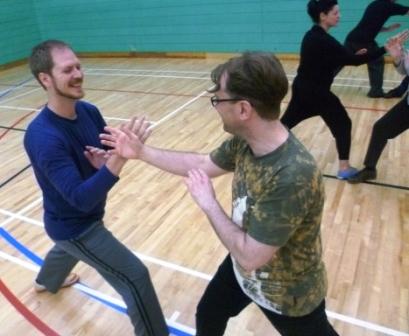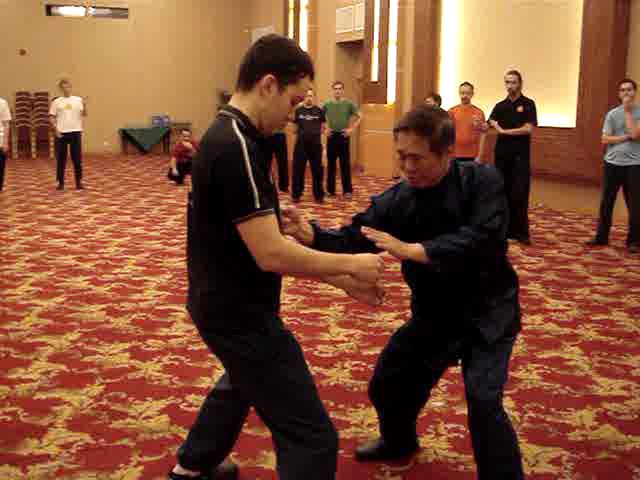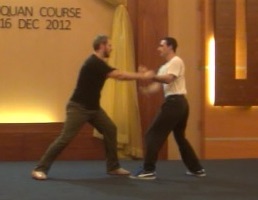ASKING BRIDGE AND PUSHING HANDS

Pushing Hands in Taijiquan
Question
May I ask how would "Asking Bridge" enrich my "Pushing Hands" practice?
Is "Asking Bridge" serving the same purpose as "Pushing Hands"?
Santiago
Answer
"Asking Bridge" refers to a special method of training in Southern Shaolin or Hoong Ka Kungfu where two practitioners connect their forearms to develop certain combat skills.
In the Asking Bridge course in Frankfurt in September 2014, I use the term in a wide sense to including Taijiquan Pushing Hands, Wing Choon Sticking Hands, and Wuzuquan Kneading Hands.
To differentiate the wide and narrow meaning of “Asking Bridge”, I should coin a different term for the wide meaning, and leave Asking Bridge for the narrow meaning in Hoong Ka Kungfu. I think of “Connecting Hands” or “Thap Sau” in Chinese, and “Connecting Bridge” or “Thap Kiew”.
At first I thought of using “Connecting Hands” because of the four training methods of connecting the forearms, three of them use the term “Hands”. However, “Thap Sau” is already a popular technical term in Chinese, as in warding off an opponent’s punch using “Single Tiger Emerges from Cave”.
Participants at my Intensive Shaolin Kungfu courses would remember I often remind them that “Single Tiger Emerges from Cave” was not a block but a “leaning” technique, i.e you don’t block your opponent’s punch but “lean” on it, which enables a dainty lady to deflect a powerful attack from an able-bodied male without bruising her forearm. This “leaning” technique is called “thap sau” in Chinese (Cantonese). “Connecting Hand” is also called “thap sau”, For better clarity, the “thap” in the former “thap sau” is translated by me as “lean”, whereas the same “thap” in the latter “thap sau” is translated as “connect”.
Hence, to avoid confusion with “leaning hand” which is a warding off technique, I use “Connecting Bridge” instead of “Connecting Hand” for the wider meaning of “Asking Bridge”.
In the narrow meaning of “Asking Bridge”, much force is used. It is more a testing of force than a training for sensitivity. Using internal force, or mechanical strength for those who don’t know or don’t have internal force, a practitioner tries to press down the forearm of a training partner or actual opponent in a real fight, so as to strike him.
For many people this method is actually detrimental to a training of sensitivity. If they have no internal force, they would use mechanical strength, usually without their being aware of the difference, thus blocking their energy flow and negating sensitivity. Even if they have internal force, they may not know how to relax and use it. They may, for this purpose, tense their arm and distract from their sensitivity.
In our school, because we understand its underlying philosophy, and have the skills and techniques to apply Asking Bridge more efficiently, we are able to change this problem into an opportunity for improvement. This situation will enable our students to learn to relax and let their chi flow, like the case of the unbendable arm.
If an opponent is more powerful, we can use the “leak” or “lau” technique of Hoong Ka Kungfu, which many Hoong Ka students may have heard of but do not really understand. In the “leak” technique, when a more powerful opponent presses our forearm down, we let go and circulate around his forearm from below to above, and then strike him. Hence, we progress from the narrow meaning of “Asking Bridge” to its wide meaning. This counter is well practiced in Wuzuquan Kneading Hands.
When I was practicing Kneading Hands with my siheng, Sifu Chee Boon Leong, in Sifu Chee Kim Thong’s Wuzuquan school, my siheng often placed his forearms on my forearms, and I couldn’t move away. I did not know how to apply the “leak” technique then. Participants attending the Asking Bridge course in Frankfurt in September 2014 will learn in a few days what I didn’t learn in two years!
Hence, “Asking Bridge” in its narrow sense in our school will enhance “Pushing Hands”, though it could be detrimental in most other schools. Because of our breadth and depth, we can be relaxed while being forceful. This is a direct complement to Taijiquan “Pushing Hands” when we can be forceful while being relaxed. In most other schools where there is no breadth and depth, students can be forceful in “Asking Bridge”, but they are tensed; students can be relaxed in “Pushing Hands” but they are not forceful. It is simply incredible that our students will learn, or refine their skills if they already have them, to be forceful and relaxed at the same time in just a few days of the Asking Bridge course.

Sticking Hands in Wing Choon Kungfu
“Asking Bridge” in its wide sense will enhance “Pushing Hands” even more, and vice versa. If all other things were equal, relatively Sticking Hands in Wing Choon will develop sensitivity more than Pushing Hands in Taijiquan. Strikes as well as defences in Wing Choon are also more direct, aiming for economy of movement whereas Taijiquan movements are more yielding and circular.
When an opponent strikes, for example, a Wing Choon practitioner even without moving his defending hand but by just rotating his waist, he can effectively deflect the attack. A Taijiquan practitioner would sink back his stance, rotate his waist and deflect the attack in a circular manner. The Wing Choon defence is less than a quarter the time and distance of the Taijiquan defence, which means it is four times faster.
This does not necessarily mean that the Wing Choon defence is better than the Taijiquan defence. As I have explained elsewhere, it may be more advantageous to use the Taijiquan defence in certain situations even when we also know the Wing Choon defence.
But it is certainly better to know both and be able to apply them in the right situations than to know only one. In our school, with the great advantage of breadth and depth as well as a sound understanding of their philosophy, the two methods enhance each other. In other schools without breadth and depth, and without philosophical understanding, practicing both methods may distract each other.
Even when we use just one of these two methods, instead of choosing the right one in a particular combat situation, we will also be able to apply our chosen method more efficiently because we have also trained in the other method. In using the Taijiquan defence, for example, we may, if the situation warrants it, sinks our stance just a bit instead of the usual way. Reversely, in using the Wing Choon defence, we may, for some useful purposes, delay the defence movement by guiding the attacker’s hand in a bigger movement.
These fine points differentiate a master from a student. It also contributed to my being undefeated in my many sparring sessions and real fights in my younger days.
As in many questions in kungfu and chi kung, the answer to whether “Asking Bridge” serves the same purpose as “Pushing Hands” can be yes or no, or yes and no.
In the narrow meaning of “Asking Bridge”, the answer is no. “Asking Bridge” serves the purpose of testing force, whereas “Pushing Hands” serves the purpose of training footwork.
This is reducing the many benefits of training these two methods to its main benefit or purpose. Besides testing force, Asking Bridge also trains and tests stance and leverage. Besides training footwork, Pushing Hands also train body-movement, hand techniques, being relaxed and flowing movement.
Many Taiji practitioners think, wrongly, that Pushing Hands train combat. Even when they are proficient in Pushing Hands, they may not be proficient in combat. In the first place, most opponents would not have their arms in contact with theirs. Moreover, their opponents may attack with kicks, felling attacks, and chin-na which are normally not found in Pushing Hands.
Pushing Hands is an ingenious way to train skills, a fact many Taiji practitioners may not realize, as evident in their performance of Pushing Hands in a demonstrative manner with little application of skills. To be combat efficient, they have to progress to Striking Hands, or Da Shou, and free sparring, or San Da.
In its wide sense of “Asking Bridge”, the answer is yes, it serves the same purpose of Pushing Hands. Besides its main purpose of training footwork, or whatever purpose one may designate for Pushing Hands, Asking Bridge surpasses it because besides Pushing Hands, we also learn Asking Bridge in its narrow meaning, Sticking Hands and Kneading Hands.
For fun and a play on language, the correct answer may also be no, it does not serve the same purpose of Pushing Hands because Asking Bridge surpasses it, and give the same justification as above.
Even when we leave out Pushing Hands in the wide sense of Asking Bridge, and consider only Asking Bridge in its narrow sense, Sticking Hands and Kneading Hands, we can also answer yes or no depending on how we use language. It is a reminder of what some philosophers regard language as “false names”, used to describe an approximation of reality, not reality itself.
We may, for example argue that no, Asking Bridge does not serve the same purpose of Pushing Hands. Asking Bridge serves to improve combat, whereas Pushing Hands serves only to improve combat skills.
Or we may argue that yes, Asking Bridge serves the same purpose of Pushing Hands. Both training methods serve to enrich our daily life.
I shall leave you to your intellectual pleasure – but not intellectual enslavement.

Kneading-Hands in Wuzuquan
Four Sequences of Asking Bridge
Glimpse of Asking Bridge, Saariselka 2011
Treasure House of Kungfu Sets
Treasure House of Combat Application
Those who wish to attend the 18-Lohan Fist course in Frankfurt, Germany on 26th, 29th, 30th September and 1st October 2014, please contact Secretary, Wahnam Germany or phone (069) 904-31954.
The questions and answers are reproduced from the thread 10 Questions on Asking Bridge in the Shaolin Wahnam Discussion Forum.
LINKS
